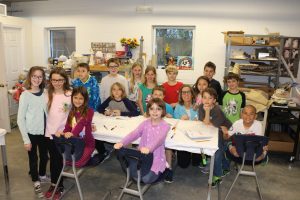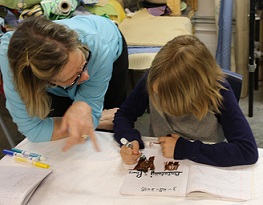by Andrew Blair
Riverside art teacher Peggy Healy appreciates that engaging dyslexic kids’ sense of creativity plays a vital role in their development.
She knows better than most. Mrs. Healy has been the school’s art teacher for the past 23 years and is a registered art therapist with the American Association of Art Therapists (AATA) since 1982. Art therapy, as described by the AATA, is “an integrative mental health and human service profession that enriches the lives of individuals, families and communities through active art making, creative process, applied psychological theory and human experience within a psychotherapeutic relationship.”
Experience has taught her that all children, especially those who are struggling, can benefit from the use of art to help them gently challenge themselves, take risks in a safe environment and connect with new emotions to build a bridge of communication and understanding where there might have been disconnection and isolation.
Mrs. Healy will retire at the end of the school year and take with her a legacy that entailed basically single-handedly facilitating the art program’s growth at Riverside. When she started, the art program shared a room with the library and students could only participate in art classes for 15 minutes on Wednesdays, primarily because of limited time and an even more condensed space.
Within a few years, with the support of administrators and teachers, that dynamic got altered—the art room got a space of its own and her class became an important and dedicated part of the school’s curriculum. It remains so today.
“I just understood how important it was to use art to help and really be able to relieve some of the frustration, to relax and stretch the brain and get it ready to learn some more,” Mrs. Healy says.
Her first touchpoint with dyslexia was very personal. Her daughter, Paige, was a 7-year-old first-grader when she was diagnosed with dyslexia at a time when the information, science and treatment of the learning disability wasn’t what it is now. Paige came to Riverside a few days a week to get tutoring help. She became a student at Riverside for the next four years. The result turned out to be life-altering.
Mrs. Healy remembers the time vividly.
“She just felt so safe here. She hugged me like she was going to the lions when she had to leave and continue on in a school where they were supportive as much as they could be, but she just didn’t know what the heck was going on,” Mrs. Healy recalls. “It was like a jungle out there. Riverside was really a very safe haven for Paige and gave her the tools she needed.”
 During her career at Riverside, Mrs. Healy has changed more than a few lives along the way. That’s partly because on an organic level, she’s demanded that students think diversely, create imaginative artwork and use their innate skill ‘thinking outside the box,’ according to Mrs. Healy, to reflect part of their inner self. That’s where the dynamic of art therapy, Mrs. Healy’s specialty, comes in.
During her career at Riverside, Mrs. Healy has changed more than a few lives along the way. That’s partly because on an organic level, she’s demanded that students think diversely, create imaginative artwork and use their innate skill ‘thinking outside the box,’ according to Mrs. Healy, to reflect part of their inner self. That’s where the dynamic of art therapy, Mrs. Healy’s specialty, comes in.
“I asked each student to use colors, shapes and symbols and realistic drawings to express feelings and what’s going on inside of you,” Mrs. Healy explains. “And sometimes you might not really know what’s going on inside of you, but when you start to be able to explore it by even identifying a color with the feeling and then putting those feelings on paper any way you want, you might be able to take a look.”
Additionally, Mrs. Healy appreciates that a child’s expression in the area of art can provide a window to their soul. That’s part of the reason why she gives each child in her classes an art journal and a feeling vocabulary. For a lot of kids’ the exercises that accompany art classes are a door-opener and gateway to enhancing their learning process beyond the Art Room.
“We learn how to attach a color to a certain feeling,” Mrs. Healy says. “Like I’ll say, ‘How are you feeling today?’ I’ll have them list five feelings. Then, we explore feelings and what they are. And it might be angry, happy, sad, love, confused. I’m anxious. I’m frustrated. I’m peaceful. I’m excited.”
That’s just one part of the practice.
“Then, I’ll say, ‘OK, pick out a color that goes with each one of those feelings today. It doesn’t have to be a forever thing. It can be just today.’ And then they’ll do that,” Mrs. Healy says. “And then I’ll say, ‘OK, now draw shape. What kind of shape do you want to be today? Are you wobbly—or, you know, just a fluid shape. Are you really stiff today? Do you have sharp edges on you? Do you have smooth edges on?’ ”
Soon, students start to unpack their emotions and become increasingly self-aware. Lest one think that her classes have all been about shapes and feelings, Mrs. Healy appreciates that dyslexics often have an advantage in that they often have to learn in a manner that marries structure and substance with improvisation and creative thinking.
“Peggy inspires her students to create beautiful art, and she does it in a way that often surprises her students with what they can accomplish,” says Hal Waller, Riverside’s Head of School.
Mrs. Healy also ensures that students discover the arts and create projects by incorporating variety that includes the use of watercolors, acrylic paint, perspective, a found object and more. Taken a step further, in her classes students study artists such as Vincent van Gogh, Pablo Picasso and many others, as well as gaining an appreciation for art in a historical context.
During this academic year, when the popular Terracotta Army exhibit was at the Virginia Museum of Fine Arts, students made miniature sized terracotta warriors in class. In the process, Mrs. Healy ensured that the fun extended beyond the Riverside campus.
“I had four students come up to me and say, ‘I told my parents that we need to go see the terracotta warriors (at VMFA),’ ” Mrs. Healy says with a smile.
No matter how Oscar Wilde’s old saying, ‘Life imitates Art far more than Art imitates Life’ is interpreted, Mrs. Healy wants each boy or girl to know that they start with a clean canvas that is ready for their use as they explore their place in the world.
 “I really feel like my goal at Riverside was not necessarily to teach art, but was to use the art to help the students really be able to regroup and have a safe place where there wasn’t a fear of failure,” Mrs. Healy says. “I want to give them a place just to get their energies out. I let the kids move around and get their supplies, let them talk while they’re working—as long as they’re very respectful listening when I’m giving a directive. I’ve always wanted to be able to give them a place to put out their feelings and explore a little bit.”
“I really feel like my goal at Riverside was not necessarily to teach art, but was to use the art to help the students really be able to regroup and have a safe place where there wasn’t a fear of failure,” Mrs. Healy says. “I want to give them a place just to get their energies out. I let the kids move around and get their supplies, let them talk while they’re working—as long as they’re very respectful listening when I’m giving a directive. I’ve always wanted to be able to give them a place to put out their feelings and explore a little bit.”
Mrs. Healy’s journey has invigorated her love for the arts and passion for discovery. Her undergraduate degree is from The University of Buffalo, N.Y. in Art and Psychology and her master’s is in Art Therapy from Pratt Institute in Brooklyn, N.Y. Today, she is a registered / Board Certified Art Therapist with the American Art Therapy Association. She is also a recipient of a Rotary International Ambassador Scholarship and studied porcelain and raku, an advanced ceramic technique, in Seto, Japan, for a year and a half. She’s taught pottery in both the United States and England.
It only seems appropriate that ‘heal’ is a large player in her last name, because Mrs. Healy has helped plenty of people from kids to the homeless to the downtrodden. Prior to coming to Riverside, she used art therapy with patients at Poplar Spring Hospital in Petersburg, many of whom suffer from psychiatric and substance abuse issues.
Even with her impressive and far-reaching credentials, Mrs. Healy believes that art can teach life lessons that she believes translates to students.
“It’s just really simple: Just be nice. Be nice to oneself. Be nice to the people in the classrooms, in their family and in the community,” Mrs. Healy says. “Let them think about what their strengths are. What are the things I think I need to work on? How can I help at home? How can I help my family? Giving them a little more so every time they’re here, they continue to be a nice person and to remember that everybody has feelings.”
As for Peggy’s daughter, Paige, the one struggling in school before arriving at Riverside? She turned out better than OK. Her impressive journey has included working with National Outdoor Leadership to attending the Italian Culinary Institute in Italy. She’s now the creative officer for the HOUSEpitality Family restaurant group, owners of The Boathouse and Casa del Barco restaurants.
Today, Paige appreciates the importance of parental support and unfailingly notes the powerful impact Riverside had on her development.
“My parents got me to Riverside because we thought this is where I needed to be to be able to show people how intelligent I am, to communicate that effectively and to be able to go off to other schools to use the information I gained here to really just excel,” Paige told a group of Riverside students recently.
Within the past few months, Mrs. Healy lost her mother, who was active in smoothing the path for people who faced a rocky climb through the uncertainties of life. One of nine children, Mrs. Healy and her husband, Kevin, plan to do some traveling and spend more time visiting family.
The hard truth is impossible to ignore. Though she’ll always be a part of Riverside, her presence will be sorely missed.
“I thought it would have been another couple of years, but I think now’s the time,” Mrs. Healy says.
